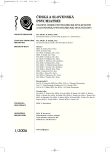Membranes II: Nerve Cell Membrane in the Development, Stress, Nutrition Alterations and during Neuroplastic Changes
Authors:
J. Mourek 1,2; M. Langmeier 1; J. Pokorný 1
Authors‘ workplace:
Fyziologický ústav 1. LF UK, Praha
; přednosta prof. MUDr. O. Kittnar, CSc.
Zdravotně sociální fakulta Jihočeské univerzity, České Budějovice
1; přednosta prof. MUDr. M. Velemínský, CSc.
2
Published in:
Čes. a slov. Psychiat., 102, 2006, No. 1, pp. 31-35.
Category:
Comprehensive Reports
Overview
During the postnatal development the representation of n-3 polyenic fatty acids increases. In the human foetus their concentration has a distinct gradient between the maternal and foetal blood. During ageing the content of polyenic fatty acids decreases and the membrane fluidity diminishes. Stressors (hypoxia, ischemia, hypo - or hyperglycaemia, fever, infection, stimulation overload and pain, restriction of movements etc.) increase production of oxygen radicals, which activate phospholipases and impair membrane of the nerves cells.
The developing and migrating neuronal precursors and growing neuronal processes are guided by specific components of cell membranes – adhesive proteins. Similar mechanisms are responsible for the neuroplastic processes of the formation, remodelling and recovery of neuronal circuits. Changes in the expression of adhesive proteins brings about possible impairment of the formation and function of the modulatory neuronal circuits, changes in the release of neurotransmitters in the hippocampus and cerebral cortex and thus alterations of the integratory functions of the nerve system.
Specific proteins of the presynaptic membrane make possible the interaction of synaptic vesicles with the cell membrane and the exocytotic release of neurotransmitter. There exist two mechanisms of the neurotransmitter release. When the calcium level in the presynaptic terminal is comparatively low, vesicles fuse with the membrane for longer time; when calcium level is high, vesicles are released immediately after the neurotransmitter was discharged.
Key words:
structure of the membrane, stress, nutrition, presynaptic element, neuronal circuits, adhesive proteins.
Labels
Addictology Paediatric psychiatry PsychiatryArticle was published in
Czech and Slovak Psychiatry

2006 Issue 1
Most read in this issue
- Parental Alienation Syndrome
- Childhood Autism: A Research Update
- Pharmacotherapy for Cognitive Dysfunction in Schizophrenia
- Sexual Aggression in Women
